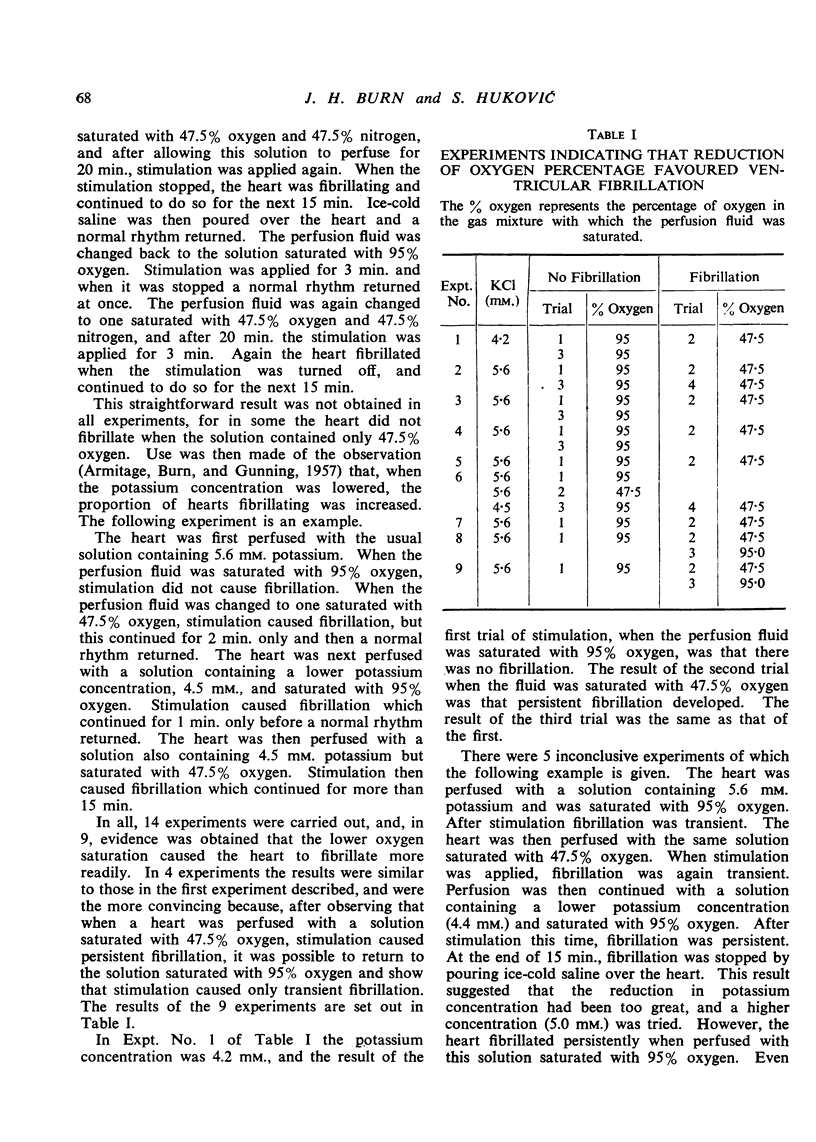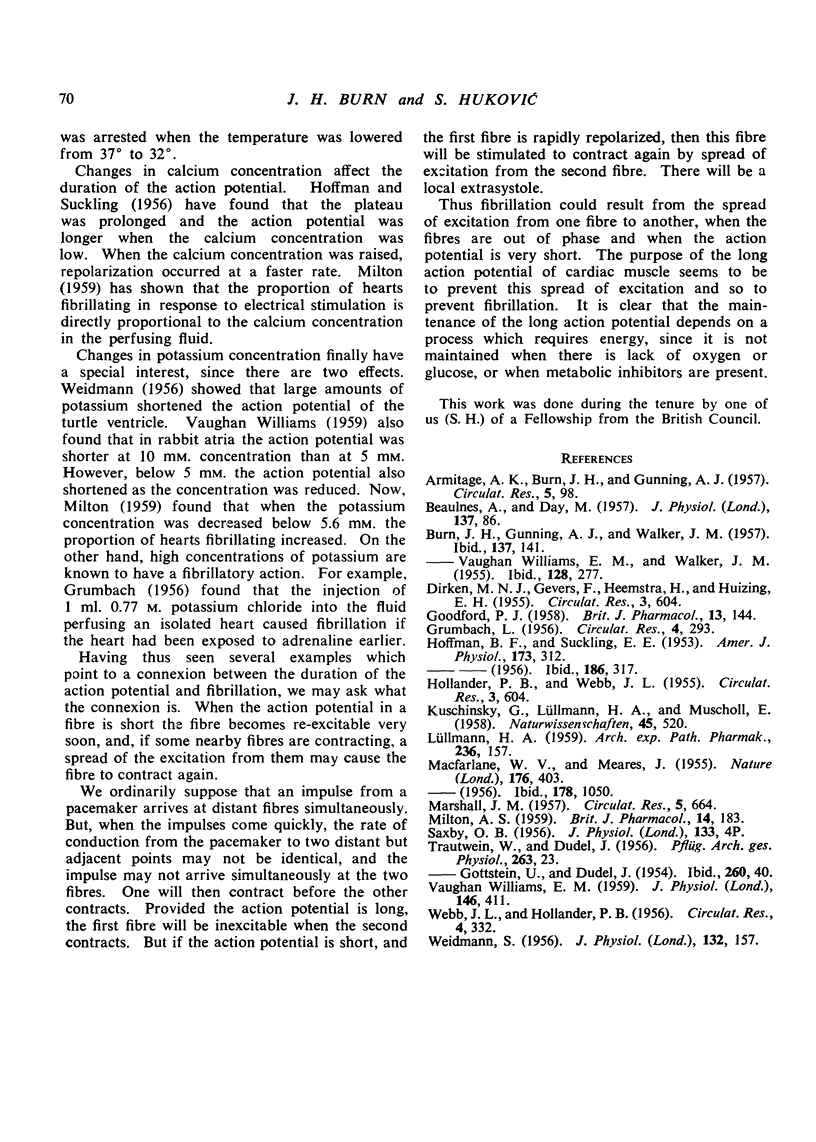Abstract
Experiments are described showing that ventricular fibrillation is more readily produced in isolated rabbit hearts by electrical stimulation when the oxygen supply to the heart is reduced. This evidence completes investigations which have been made into factors affecting the production of fibrillation. These investigations have shown that factors which shorten the duration of the action potential, particularly those which cause the “plateau” to disappear, facilitate fibrillation, and those which lengthen the duration of the action potential prevent fibrillation. The reason for the length of the cardiac action potential may therefore be to prevent fibrillation. When the action potential is of normal length the fact that two adjacent fibres are out of phase does not matter; the one which is first to contract is not re-excited by the one which is second to contract, because at that moment the first is inexcitable. If the action potential is short, then the first may be already repolarized and may be excited by spread of excitation from the second. Factors which inhibit metabolism shorten the action potential.
Full text
PDF



Selected References
These references are in PubMed. This may not be the complete list of references from this article.
- ARMITAGE A. K., BURN J. H., GUNNING A. J. Ventricular fibrillation and ion transport. Circ Res. 1957 Jan;5(1):98–104. doi: 10.1161/01.res.5.1.98. [DOI] [PubMed] [Google Scholar]
- BEAULNES A., DAY M. Effect of temperature on arrhythmia in isolated rabbit artia. J Physiol. 1957 Jun 18;137(1):86–94. doi: 10.1113/jphysiol.1957.sp005798. [DOI] [PMC free article] [PubMed] [Google Scholar]
- BURN J. H., GUNNING A. J., WALKER J. M. Effects of noradrenaline and adrenaline on the atrial rhythm in the heart-jung preparation. J Physiol. 1957 Jun 18;137(1):141–153. doi: 10.1113/jphysiol.1957.sp005802. [DOI] [PMC free article] [PubMed] [Google Scholar]
- BURN J. H., WILLIAMS E. M. V., WALKER J. M. The effects of acetylcholine in the heart-lung preparation including the production of auricular fibrillation. J Physiol. 1955 May 27;128(2):277–293. doi: 10.1113/jphysiol.1955.sp005306. [DOI] [PMC free article] [PubMed] [Google Scholar]
- DUDEL J., TRAUTWEIN W. Aktionspotential und Kontraktion des Herzmuskels im Sauerstoffmangel. Pflugers Arch. 1956;263(1):23–32. doi: 10.1007/BF00412455. [DOI] [PubMed] [Google Scholar]
- GOODFORD P. J. Metabolic factors and ventricular fibrillation. Br J Pharmacol Chemother. 1958 Jun;13(2):144–150. doi: 10.1111/j.1476-5381.1958.tb00209.x. [DOI] [PMC free article] [PubMed] [Google Scholar]
- GRUMBACH L. The initiation of ventricular tachycardia and fibrillation in isolated hearts by potassium chloride. Circ Res. 1956 May;4(3):293–297. doi: 10.1161/01.res.4.3.293. [DOI] [PubMed] [Google Scholar]
- HOFFMAN B. F., SUCKLING E. E. Cardiac cellular potentials; effect of vagal stimulation and acetylcholine. Am J Physiol. 1953 May;173(2):312–320. doi: 10.1152/ajplegacy.1953.173.2.312. [DOI] [PubMed] [Google Scholar]
- HOLLANDER P. B., WEBB J. L. Cellular membrane potentials and contractility of normal rat atrium and the effects of temperature, tension and stimulus frequency. Circ Res. 1955 Nov;3(6):604–612. doi: 10.1161/01.res.3.6.604. [DOI] [PubMed] [Google Scholar]
- HOLLANDER P. B., WEBB J. L. Cellular membrane potentials and contractility of normal rat atrium and the effects of temperature, tension and stimulus frequency. Circ Res. 1955 Nov;3(6):604–612. doi: 10.1161/01.res.3.6.604. [DOI] [PubMed] [Google Scholar]
- MACFARLANE W. V., MEARES J. D. Modification of the after-potential of single muscle fibres by 2:4-dinitrophenol. Nature. 1955 Aug 27;176(4478):403–404. doi: 10.1038/176403a0. [DOI] [PubMed] [Google Scholar]
- MARSHALL J. M. Effects of low temperatures on transmembrane potentials of single fibers of the rabbit atrium. Circ Res. 1957 Nov;5(6):664–669. doi: 10.1161/01.res.5.6.664. [DOI] [PubMed] [Google Scholar]
- MILTON A. S. The relation between temperature and changes in ion concentration on ventricular fibrillation induced electrically. Br J Pharmacol Chemother. 1959 Jun;14(2):183–185. doi: 10.1111/j.1476-5381.1959.tb01381.x. [DOI] [PMC free article] [PubMed] [Google Scholar]
- TRAUTWEIN W., GOTTSTEIN U., DUDEL J. Der Aktionsstrom der Myokardfaser im Sauerstoffmangel. Pflugers Arch. 1954;260(1):40–60. doi: 10.1007/BF00363778. [DOI] [PubMed] [Google Scholar]
- VAUGHAN WILLIAMS E. M. The effect of changes in extracellular potassium concentration on the intracellular potentials of isolated rabbit atria. J Physiol. 1959 Jun 11;146(3):411–428. doi: 10.1113/jphysiol.1959.sp006201. [DOI] [PMC free article] [PubMed] [Google Scholar]
- WEBB J. L., HOLLANDER P. B. The action of acetylcholine and epinephrine on the cellular membrane potentials and contractility of rat atrium. Circ Res. 1956 May;4(3):332–336. doi: 10.1161/01.res.4.3.332. [DOI] [PubMed] [Google Scholar]
- WEIDMANN S. Shortening of the cardiac action potential due to a brief injection of KCl following the onset of activity. J Physiol. 1956 Apr 27;132(1):157–163. doi: 10.1113/jphysiol.1956.sp005510. [DOI] [PMC free article] [PubMed] [Google Scholar]


